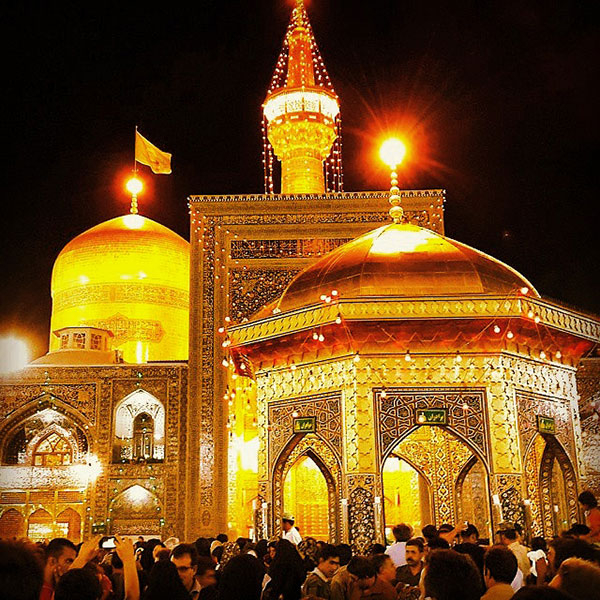Al-Sahifa al-Sajjadiyya (The Psalms of Islam)
The title Al-Sahifat al-Sajjadiyya means simply `The Book of al-Sajjad. Al-Sajjad is one of the titles given to Imam Zayn al-Abidin and signifies `the one who constantly prostrates himself in prayer. The book is often called Al-Sahifat al-Kamilat al-Sajjadiyya, that is, `The Perfect, or Complete, Book of al-Sajjad.
According to its commentator Sayyid `Alikhan Shirazi, the word kamila refers to the perfection of the style and content; some sources state that the adjective was added to differentiate it from another, incomplete version of the work, which is known among the Zaydis, but this seems less likely, given the manner in which the title is employed in the preface (verse 20). The Sahifa has been called by various honorifics, such as `Sister of the Quran, `Gospel of the Folk of the House, and `Psalms of the Household of Muhammad.
According to Shiite tradition, Zayn al-Abidin had collected his supplications and taught them to his children, especially Muhammad al-Baqir and Zayd. In later times the text became widely disseminated among Shiites of all persuasions. The specialists in the science of hadith maintain that the text is mutawatir; in other words, it was generally known from earliest times and has been handed down by numerous chains of transmission, while its authenticity has never been questioned. Nevertheless, the arrangement of the text allows us to draw a certain distinction between the fifty-four supplications which make the main body of the text and the additional supplications which make up the fourteen addenda (including the prayers for the days of the week) and the fifteen munajat or `whispered prayers. The original fifty-four supplications show an undeniable freshness and unity of theme and style, while the latter, especially the munajat, add a certain orderliness and self-conscious artistry which may suggest the hand of an editor. The addenda are said to have been collected and added to the text by Shams al-Din Muhammad ibn Makki, known as al-Shahid al-Awwal (the `first martyr), the famous author of Al-Lumat al-Dimashqiyya in jurisprudence (fiqh) who was killed in Aleppo in 786/1384. The fifteen munajat have been added to several modern editions of the Sahifa and seem to have been brought to the attention of the main body of Shiites by `Allama Muhammad Baqir Majlisi (d. 1110/1689-9 or a year later), author of the monumental compilation of Shiite hadith, Bihar al-Anwar.
Many supplications have been handed down from Imam Zayn al-Abidin in addition to those recorded in the text of the Sahifa as given here, and various scholars have collected these together in a series of works known as the `second Sahifa the `third Sahifa and so on. The second Sahifa which is about as long as the Sahifa itself, was compiled as the `sister of the Sahifa by Muhammad ibn al-Hasan al-Hurr al-Amili (d. 1104/l692-3), author of the famous Wasail al-Shi`a in the year 1053/1643. A third Sahifa was put together by the author of Riyad al-ulama Mirza Abd Allah ibn Mirza `Isa Tabrizi, known as Afandi and a student of Majlisi. The longest of the published versions is Al-Sahifat al-Sajjadiyyat al-khamisa (`The Fifth Sahifa of al-Sajjad) by Muhsin al-Amin, the well known contemporary author of Ayan al-shia. It includes all the supplications included in the previous Sahifas; 130 of these are found in the first and second Sahifas and 52 are added. In her sympathetic study of Islamic prayer manuals, Muslim Devotions, Constance Padwick made use of this fifth recension of the text, which fills more than six hundred pages.
Any serious attempt to sort out the relative historical reliability of the individual supplications found in all the versions of the Sahifa on the basis of modern critical scholarship would be an undertaking of major proportions. The result of such a study - if one can judge by studies of other ancient texts - would probably be that, after years of toil, we would have a series of hypotheses, leaving varying degrees of doubt. This would be of interest to Western scholars and modernized Muslims, both of whom, in any case, have no personal involvement with the contents and teachings of the Sahifa. But the attitude of most Muslims has been to look at the content of the texts established by the authority of tradition and not be too concerned with who actually wrote the words in `historical fact. In this regard the saying of Ali is well known: `Look at what has been said, not at who has said it, since only the truth or untruth of the words is of real concern. From this point of view, if the author of the Sahifat al-kamila was not Imam Zayn al-Abidin, he - or they - would in any case have to have been a spiritual authority of equal rank, so the whole exercise leaves us where we started: with a text which expresses the highest aspirations of the Muslim soul.
However this may be, we can be satisfied to have the core text which has been attributed to Zayn al-`Abidin by centuries of Shiite tradition. In other words, in the fifty-four basic prayers of the Sahifa we have the Zayn al-Abidin who has been known to Shiites for more than a thousand years and who has helped give to Shiism its specific contours down to the present day. Scholars may eventually reach the conclusion that the Zayn al-Abidin of historical fact differs from the Zayn al-Abidin of tradition, but this will remain a hypothesis, since at this distance historical facts are impossible to verify and as open to interpretation as literature. Whether or not historians accept the text as completely authentic will not change the actual influence which Zayn al-Abidin and the Sahifa have exercised upon Islam over the centuries, nor is it likely to change the way they continue to influence practising Muslims. The real Zayn al-Abidin is the figure enshrined by the text as it now stands.
The opinion of the writer of these lines concerning the authenticity of the Sahifa - admittedly based only upon an intimate acquaintance with the text gained through many months spent in translation - is that the original fifty-four prayers go back to Zayn al-Abidin, that the addenda are nearly as trustworthy, and that the munajat may have been worked upon by others. But the Sahifa in its larger forms probably contains a good deal of material from later authors. It is interesting to note Padwicks comments on the Sahifat al-khamisa: `The great body of devotion attributed to him is characterized by a deep humility and sense of sin, and by an intransigent, undying resentment against the foes of his house. Only the first half of this statement is true about the present Sahifa. Though the Imam makes a number of allusions to the injustice suffered by his family and the fact that their rightful heritage has been usurped, no one can call this a major theme of the Sahifa or an intransigent, undying resentment. In the one instance where Zayn al-Abidin speaks rather explicitly of the injustice suffered by the Imams (48.9-11), this is accompanied by an admission of Gods wisdom in His ordainment.
THE SAHIFA AND ISLAMIC SPIRITUALITY
In spite of studies that have rejected the idea, many people in the West still believe that `true Islam lies in simplicity, austerity, legalism, formalism, and a God perceived as Just and Transcendent. Hence those elements of Islamic civilization which demonstrate complexity, subtlety, warmth, love, inwardness, spirituality, and a God of mercy, compassion, and immanence are seen as largely extraneous to or reactions against Quranic Islam. Scholars such as Massignon have pointed out that a person of spiritual sensitivity only needs to read the Quran for such ideas to be dissolved. But few people who have adopted the old stereotypes possess this sort of sensitivity or would be interested in changing their preconceived ideas, lest sympathy be stirred up in their hearts. It is not my aim here to reject, as so many have done before me, these common biases concerning the nature of `true Islam, but I would like to point out that a work like the Sahifa brings out an inward dimension of Islam which may be much more difficult to perceive in other early texts.
When scholars and other outsiders look at Islam, they naturally perceive what can be seen at first glance, that is, events, written reports and records, social relationships, and so on. It is not easy to look into peoples hearts or to investigate their personal relationship with God, nor are most people interested in doing so. If there is a way into hearts, it must come by studying the most inward concerns of individuals as reflected in their outward activities and writings. But those dimensions of Islam which have caught the most attention of outside observers are external and obvious, and they also happen to be relatively devoid of the love and warmth normally associated in the West with spirituality.
Islamic civilization as a whole is much like a traditional Muslim city: The outer walls make it appear dull and sombre, and it is not easy to gain access to the world behind the walls. But if one becomes an intimate with the citys inhabitants, one is shown into delightful courtyards and gardens, full of fragrant flowers, fruit trees, and sparkling fountains. Those who write about Islamic history, political events, and institutions deal with the walls, since they have no way into the gardens. Some of the gardens are opened up through the study of Sufism, art and architecture, poetry, and music, but since all of these have appeared in specific historical forms influenced by the surrounding environment, their deep Islamic roots can easily be lost to sight. The most traditional and authentic gardens of the city, and the most difficult of access, are the hearts of the greatest representatives of the civilization. It is here that the supplications handed down from the pillars of early Islam can open up a whole new vision of Islams animating spirit, since they provide direct access to the types of human attitudes that are the prerequisite for a full flowering of the Islamic ideal.
OTHER DIMENSIONS
This introduction may seem to be suggesting that the Sahifa deals exclusively with Islamic spirituality. But the Sahifa deals with other domains as well. As was pointed out above, the great representatives of Islam bring together all levels of Islamic teachings, just as these are brought together by the Quran and the hadith. If spirituality has been emphasized in discussing the Sahifa, this has to do with the fact that the work is a collection of supplications, and these presuppose certain attitudes toward the Divine Reality which cannot be understood outside spiritualitys context.
But the Sahifa also provides teachings that are applicable on many different levels, from the theological (in the broadest sense of the term) to the social. A thorough analysis of these would demand a book far longer than the Sahifa itself. It is hoped that the publication of this translation will encourage scholars to study the content of the prayers contained in the Sahifa (as well as the prayers left by other pillars of early Islam, the Shiite Imams in particular) to bring out the whole range of teachings they contain. The most that can be done here is to allude to some of the other important topics touched upon by the Sahifa and mention a few of the significant questions which these bring up.
Islam is an organic reality possessing three basic dimensions: practice or the Sharia (al-islam) faith (al-iman which includes doctrine and intellectual teachings), and spirituality (al-ihsan). In the lived experience of the community, these dimensions are intimately interrelated, even if various institutional forms tend to deal with them separately. The earliest sources, such as the prophetic hadith or `Alis Nahj al-balagha deal with all three of these dimensions, though different passages can be isolated which stress one specific epic rather than another. But a work like the Nahj al-balagha converges profoundly from the Sahifa in that it brings together sayings on all sorts of matters, from metaphysics, to the nature of correct government, to the personal flaws of some of `Alis contemporaries. There is no stress on spirituality, since this is clearly one dimension of Islam among others, though a deep spirituality and holiness underly everything that Ali says.
In contrast, the Sahifa by its supplicatory form and content, stresses the innermost dimension of Islam. But at the same time, it also touches upon Islams other dimensions. For example, the traditional category of `faith is concerned with God, the angels, the prophets, the scriptures, the Last Day, and the `measuring (qadar) of both good and evil. These objects of faith form the basic subject matter of most of Islamic thought as developed in kalam philosophy, and theoretical Sufism. Imam Zayn al-Abidin discusses all of these in the Sahifa sometimes briefly and sometimes in detail. Thus he often mentions the angels, while his `Blessing upon the Bearers of the Throne (3) provides the best available summary of Muslim beliefs concerning them.
The Imam also refers frequently to the domain of Islamic practices, or the Sharia in the wide sense. He emphasizes the absolute necessity of following Gods guidelines as set down in the Quran and the hadith in both individual and social life. Hence the Sahifa provides many specific social teachings as well as general injunctions, such as the necessity of establishing justice in society. But since the social teachings deal with the domain of practice, the outermost dimension of Islam, they need to be viewed within the context of the Imams doctrinal and spiritual teachings. As he makes eminently clear in his `Treatise on Rights, a hierarchy of priorities must always be observed: The individual comes before the social, the spiritual before the practical, and knowledge before action. Each human being has a long series of social duties, but these depend upon his more essential duties, which are first, faith in God, and second, placing ones own person into the proper relationship with the Divine Reality.
Courtesy of Darol Hadith
The following is a supplication by Imam Zayn al-Abidin in Asking for the Best
(Supplication – 33 of Al-Sahifat al-Kamilat al-Sajjadiyya)
O Allah,
I ask from Thee the best in Thy knowledge,
so bless Muhammad and his Household
and decree for me the best!
Inspire us with knowledge to chose the best
and make that a means to
being pleased with what Thou hast decreed for us
and submitting to what Thou hast decided!
Banish from us the doubt of misgiving
and confirm us with the certainty of the sincere!
Visit us not with incapacity
to know what Thou hast chosen, lest we
despise Thy measuring out,
dislike the place of Thy good pleasure,
and incline toward that which is
further from good outcome
and nearer to the opposite of well-being!
Make us love what we dislike
in Thy decree
and make easy for us what we find difficult
in Thy decision!
Inspire us to yield
to that which Thou bringest upon us by Thy will,
lest we
love the delay of what Thou hast hastened
and the hastening of what Thou hast delayed,
dislike what Thou lovest,
and choose what Thou dislikest!
Seal us with that which is most praised in outcome
and most generous in issue!
Surely Thou givest generous gain,
bestowest the immense,
dost what Thou wilt,
and Thou art powerful over everything.
Source: darolhadith.com and duas.org

















